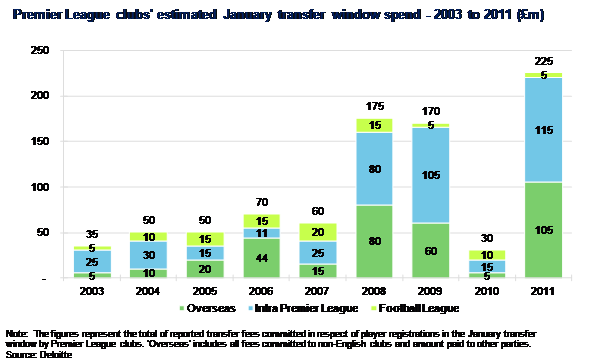By Andrew Warshaw
February 1 – The staggering £225 million spent by Premier League clubs in the January transfer window, including the £35 million Liverpool paid to buy Andy Carroll (pictured) from Newcastle United, beat the previous record in 2008 by £50 million, according to report by accountants Deloitte.
About 80 percent of the spending was done by four clubs – Chelsea, Liverpool, Aston Villa and Manchester City.
Dan Jones, partner in the company’s sports business group, said that while Premier League club revenues had never been higher, he was still surprised that the figure topped £200 million.
Yet he pointed out that this had been “a particularly polarised window, with only a few clubs flexing their financial muscles, on what was a deafening final day of an otherwise quiet window.”
Just to put into perspective the difference between the haves and have-nots, spending between Premier League clubs accounted for just over half (£115 million) of the total, followed by spending with overseas clubs (£105 million) – with Football League clubs involved in just £5 million worth of business.
Clubs in England’s top flight spent far more overall in January than those in other European leagues.
“For the majority of clubs, the combination of a continued lack of available credit and reduced operating profitability and liquidity continues to be the norm, which has put the brakes on their spending,” said Jones.
“However, the higher and more evenly shared revenues seen in the Premier League have again seen its clubs outspend clubs in the top divisions in France, Germany, Italy and Spain.”

Reflecting on the record spending, Alex Byars, senior consultant in the Sports Business Group at Deloitte, claimed that the competitiveness of the Premier League had encouraged clubs to splash out the record sums.
“With only 10 points separating the teams in 8th and 20th position, this season’s Premier League is one of the most competitive on record,” he said.
“Clubs receive an extra £1 million broadcast payment per higher league finishing position, so it is no surprise that five of the top six transfers by value relate to strikers, as clubs seek the goals needed to propel them up the league.
“For Aston Villa and Liverpool, this was the first chance for their new managers – and, for the latter, its new owners – to invest in their playing squads as they seek to improve their league position.
“Manchester City were relatively restrained by recent standards but continue to strengthen an already formidable squad, whilst the window’s biggest spenders, Chelsea, spent more than £70 million to send a strong message to their rivals about their intent to finish in the fop four.
“Premier League clubs benefit from loyal supporters, high quality modern stadia, long-term broadcast and commercial partners and the resulting strong and stable revenues, which allows them to plan with some certainty.
“The fundamental requirements for a sustainable business model remain the same as always; for clubs to appropriately manage their cost base, particularly player wage costs, relative to their largely predictable and stable revenue streams.”
Contact the writer of this story at zib.l1745043303labto1745043303ofdlr1745043303owedi1745043303sni@w1745043303ahsra1745043303w.wer1745043303dna1745043303
Related stories
February 2011: Andrew Warshaw – English spending spree leaves Platini in no doubt who is bottom of Financial Fair Play league
January 2011: Scrap January transfer window say English managers

